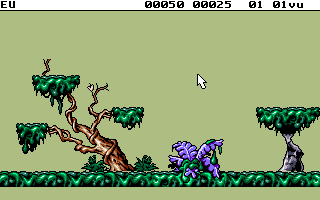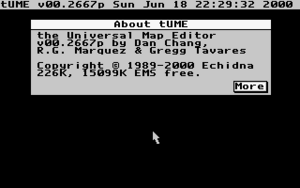Difference between revisions of "TUME"
From Sega Retro
| Line 44: | Line 44: | ||
==Downloads== | ==Downloads== | ||
| − | {{Download|file=TUME.zip|version='''00. | + | {{Download|file=TUME.zip|version='''00.2667p (2000-06-18)'''{{ref|http://web.archive.org/web/20070202064352/members.aol.com/opentume/html/download.html}} |
'''Released under Mozilla Public License 1.1.'''{{ref|https://www.mozilla.org/en-US/MPL/1.1/}}|filesize=2,6 MB}} | '''Released under Mozilla Public License 1.1.'''{{ref|https://www.mozilla.org/en-US/MPL/1.1/}}|filesize=2,6 MB}} | ||
Revision as of 08:32, 6 November 2017
| TUME ( The Universal Map Editor ) |
|---|
| Developer: Echidna; Greg Marquez, John Alvarado, Gregg Tavarez; porting: Dan Chang |
This short article is in need of work. You can help Sega Retro by adding to it.
TUME ( The Universal Map Editor ) is an open source tile based map editor (released in June 18, 2000 under Mozilla Public License 1.1.)[1] originally created and designed by Greg Marquez, John Alvarado and Gregg Tavares of Echidna for Amiga computer and later ported to MS-DOS by Dan Chang at Virgin Games request (commissioned by Dr. Stephen H. Clarke-Willson[2] an American video game producer and executive producer in the early 1990s and Vice-President of Virgin Interactive from 1991 to 1994). From 1991 to 1996 it was licensed to many video game development companies and used to create levels, maps, stages and tables for many 8-bit and 16-bit games. It is currently avaiable as freeware and it's fully usable with DOSBox emulator.
TUME distinguishes itself from other map editors of the era in several ways. One, it copies the keyboard layout of Deluxe Paint, the most popular image editing software at the time.
It has no intrinsic limits. It can edit multiple maps, each made from tiles of any arbitrary pixel size. It can even make maps made from tiles of tiles of arbitrary size nested to an arbitrary level.
It supports editing multiple maps at once (or Rooms as called in TUME software). It also allows an arbitrary number of layers per map allowing tiles to be stacked.
Another unique feature is that it features no graphic editing tools, relying on external applications like Deluxe Paint.
TUME saves a generic IFF format file (IFF standard was defined by Electronic Arts) and then relies on customized converters called TUMEPacks. These tools take the various graphics, maps, layers and based on various settings create all kinds of data including not only the graphics but things like height maps for collisions, logic mappings to map an image to a certain meaning internal to a game's logic, replacements for when areas of a map needed to be replaced at runtime during a game and many other types of data.
TUME can edit maps for just about any 8 bit or 16 bit system , including Mega Drive, Master System, Game Gear, SNES, Gameboy, Turbo-Grafx, Famicom, NES, IBM, and Amiga (hence the "Universal" in its name).
Games utilising TUME
TUME was used as the map editor for a number of Sega Mega Drive and Mega CD games including:
- Caesars Palace
- Cool Spot
- Disney's Aladdin
- Earthworm Jim
- Earthworm Jim 2
- Gargoyles
- Global Gladiators
- Mickey's Ultimate Challenge
- My Paint: The Animated Paint Program
- Pitfall: The Mayan Adventure
- RoboCop Versus The Terminator
- The Jungle Book
- The Lion King
- The Terminator (Mega-CD)
Gallery
The Official TUME Demo/Tutorial Video
Official User's Guide (by Echidna)
Downloads
| Download TUME |
Operating System: MS-DOS
External links
- Gregg Tavares page about TUME at games.greggman.com
- TUME Home Page at the Wayback Machine (archived June 23, 2013)
- Info about the IFF standard (Interchange File Format) on Wikipedia
References
- ↑ https://en.wikipedia.org/wiki/Mozilla_Public_License
- ↑ https://www.linkedin.com/in/drstephencw
- ↑ htt (Wayback Machine: 2007-02-02 06:43)
- ↑ https://www.mozilla.org/en-US/MPL/1.1/


